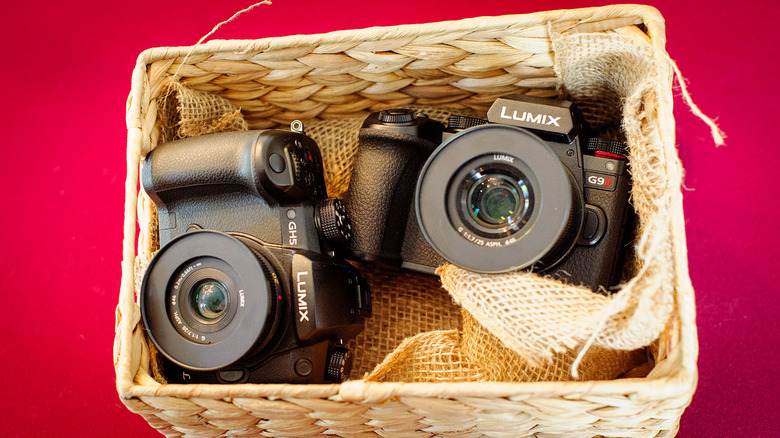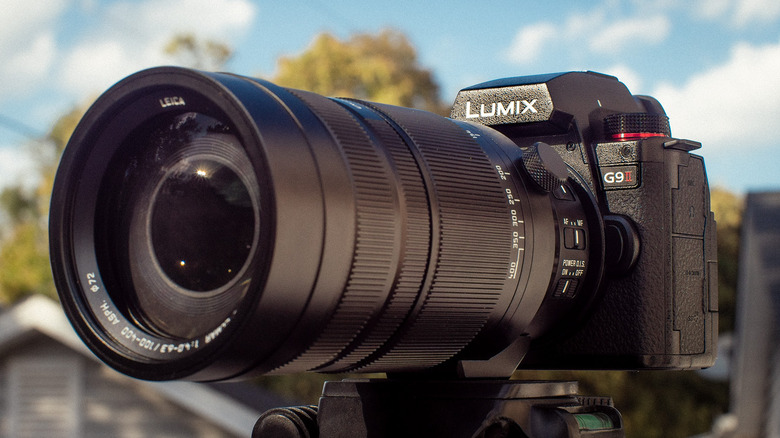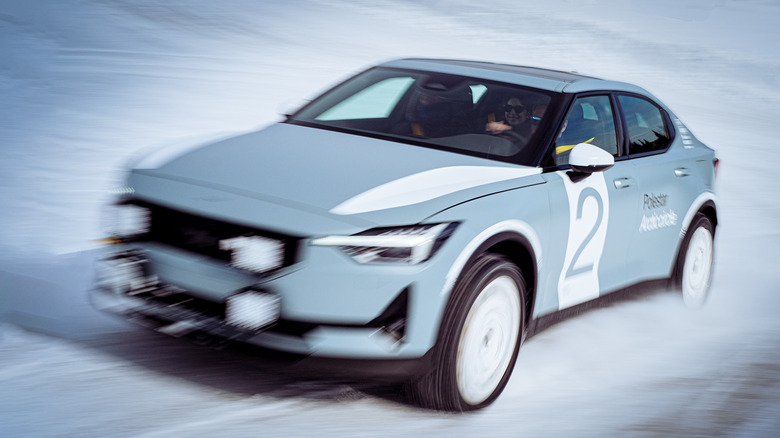Are Lumix Cameras Good Enough For Professional Photographers?
Lumix is the consumer digital camera division of the Japanese electronic manufacturer Panasonic. Beginning in the early 2000s, the company released plenty of DSLRs and compact cameras under the Lumix name, but they didn't really shake up the industry until the release of the G1 in 2008. The G1 has the honor of being the first mirrorless interchangeable lens camera on the market, also introducing the Micro Four Thirds (MFT) lens system which continues today.
The early mirrorless cameras from Lumix could offer DSLR-like performance in a compact, lightweight package. However, they had to contend with things like cheap-feeling plastic build quality, inaccurate autofocus, displays with low resolution and framerate, and poor battery life. The G1 also offered no video recording, which was added on the following iteration. In the years since 2008, Panasonic has addressed all of these flaws, building cameras that can truly live up to professional standards. DSLR makers like Sony, Canon, and Nikon have also designed mirrorless systems of their own, effectively replacing DSLRs as the tool of choice for many career photographers.
In this piece, we'll highlight what makes Lumix cameras special, and why they may be a good choice for professional photo and video-taking needs. All samples shown were taken using Lumix GH5, G9 II, and S5 II cameras. Also, read our Lumix G9 II Review and Lumix S5 II Review for more detailed information.
Photo Quality
Photographers and videographers alike praise the color reproduction of Lumix cameras. The "Natural" profile especially is a great choice for accurate depiction of colors and moderate contrast levels out of the camera. Many of Panasonic's options also include multiple built-in monochrome profiles, allowing users to select the perfect amount of contrast they want for black-and-white portraits or landscapes.
When it comes to resolution, however, Lumix seems to lag behind other options. The current Micro Four Thirds cameras, the GH6 and G9, both use a 25-megapixel sensor, while the full-frame S5 and S1 use a 24-megapixel sensor. The S1R is also available with 47-megapixel resolution at a much higher price. However, 24 megapixels is actually more than enough for the majority of photographers. You can crop well into a 24 MP image and still have enough pixels for delivery to 4K screens and online media. Super high-res sensors are only really necessary for big blow-up prints.
While using raw files, the dynamic range of Panasonic's full-frame offerings is also comparable to other professional mirrorless and DSLR systems on the market. Shadows and highlights can be recovered to a degree without visible noise or artifacts. The colors also be tweaked significantly in post-processing without banding issues. MFT sensors are less impressive on this front. Boosted shadows show noise quickly, and color banding becomes much more apparent. On smaller sensors, you will have to be more mindful of exposure in-camera.
Video Features
Before the Lumix brand, Panasonic had long been a producer of professional video cameras, and they've done a great job of incorporating those pro video features into smaller mirrorless bodies. Around 2008, manufacturers were starting to create "hybrid" DSLRs that could capture both photos and video. These revolutionized the video market but didn't record anywhere near the same quality that would come out of an HD camcorder.
In 2009, Lumix released the GH1 which featured full 1080p video. In 2014, the GH4 became the first mirrorless camera that could record footage at 4K resolution, later seeing use for POV shots on "Better Call Saul". In 2017, the GH5 added 10 bit color data, allowing editors to have color grading flexibility more in line with a cinema camera. The GH5 also added sensor stabilization which smoothed the shakiness of handheld footage. To this day, Panasonic is the one to beat for pro video quality at a consumer price.
All of these video innovations are folded into the current Lumix lineup, along with in-camera exposure tools like zebras and waveforms, and Log profiles for increased dynamic range. The G9 II and GH6 output up to 5.8k max video resolution, while the S5 II can do 6K recording. All the Lumix cameras have 3.5mm audio inputs for external microphones, along with HDMI ports for the use of large monitors and external recorders. Video can also be recorded to an SSD using the USB-C output.
Lens Options
Lumix currently offers two lens systems, the half-frame Micro Four Thirds, and the full-frame L mount. Most digital camera systems on the market today are created with proprietary lens mounts that have limited, or zero, compatibility with other brands. Lumix has done something different, designing its mirrorless systems with collaborating companies in order to share development costs and increase compatibility.
MFT was co-developed with Olympus (now OM System), and both companies continue to support the platform with new bodies and lenses. When selecting lenses, Micro Four Thirds has a nearly 15-year catalog of options from two separate companies. They also have the option of switching from a Lumix to an OM System camera and getting the same functionality, or vice-versa. Some smaller brands like DJI have also released lenses for the system.
Lumix's relatively recent full frame line takes advantage of the Leica L mount, which they call "the universal lens mount." The new system is shared across five companies: Sigma, DJI, Samyang, and Blackmagic. While the L mount hasn't built up the same back catalog as Micro Four Thirds, it promises a huge degree of compatibility, and will likely be supported for years or decades to come.
Quality for the Money
All current Lumix mirrorless cameras have magnesium metal construction with weather sealing, ensuring that they can survive all sorts of environments and keep on cranking. Compared to other brands. They also have fantastic performance against overheating in video mode. None of them will have any issues rolling 4K at standard framerates indefinitely. The GH6 and S5 II also feature built-in fans to squeeze more time out of the maxed-out video modes.
Nikon and Sony also offer fantastic build quality on their pro cameras, but the thing that should woo people over to Lumix is that they offer very comparable capability and quality for an often lower price. The majority of the Lumix lineup retails in the $2,000 range, with the S1 on the highest end at $2,500. For reference, the Sony A7S III and A7R V both go for over $3,000. The Nikon Z8 retails at $4,000, and the Canon R5 is listed for $3,400.
Being full frame, those other options will have better dynamic range performance than Micro Four Thirds. However, MFT has plenty of advantages of its own: the smaller sensor allows for faster scanning video capture, opening up higher framerates and eliminating rolling shutter artifacts. Lumix in-body stabilization is also unbeaten when it comes to taking sharp images in both photo and video. Panasonic's lineup has a ton to offer the career photographer that wants to make the switch to mirrorless, or to someone dipping their toes into the pro market.




